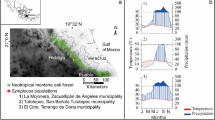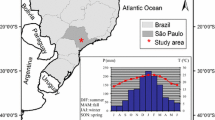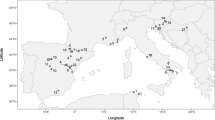Abstract
The long-term impacts of summer drought and high temperatures on xylem traits of conifers are scarcely investigated, even though such traits can play an important role in determining xylem functional performance and wood properties under the ongoing climate change. To investigate how different species are expected to react to climate change, especially summer drought, we studied the xylem plasticity of six non-native conifer species from a Danish common garden based on the hypothesis that wood anatomy variables may be particularly valuable for predicting drought resistance differences between species. We focused on two xylem functional traits (tracheid wall thickness and lumen area) and three wood properties relevant for utilisation of the material (density, microfibril angle and stiffness) and studied how they were affected by drought and temperature in the period 1975–2012. The results showed that xylem traits responded stronger to summer drought (July and August) than to temperature, especially for the part of the ring produced late in the season. The response was stronger for Larix kaempferi (Lamb.) Carr., Picea abies (L.) Karst., Picea sitchensis (Bong.) Carr. and Abies alba Mill., which formed latewood tracheids with smaller lumen and thicker walls, and wood characterised by higher density, lower microfibril angle and higher stiffness during drought years, than for Pseudotsuga menziesii (Mirb.) Franco. The latter, and to some extent Abies grandis Lindl., showed lower response of xylem traits to summer drought. P. menziesii also showed only minor effects on growth ring widths and was the conifer species showing least effects from summer drought. Retrospective comparison of xylem plasticity between different species from common gardens was thus found to provide useful hints to species selection for afforestation in light of future climate scenarios.






Similar content being viewed by others
References
Alves A, Hevia A, Simões R, Majada J, Alia R, Rodrigues J (2020) Improving spatial synchronization between X-ray and near-infrared spectra information to predict wood density profles. Wood Sci Technol 54:1151–1164. https://doi.org/10.1007/s00226-020-01207-z
Auty D, Achim A, Macdonald E, Cameron AD, Gardiner BA (2016) Models for predicting clearwood mechanical properties of Scots pine. For Sci 62:403–413. https://doi.org/10.5849/forsci.15-092
Balducci L, Deslauriers A, Giovannelli A, Beaulieu M, Delzon S, Rossi S, Rathgeber CBK (2015) How do drought and warming influence survival and wood traits of Picea mariana saplings? J Exp Bot 66:377–389. https://doi.org/10.1093/jxb/eru431
Barber VA, Juday GP, Finney BP (2000) Reduced growth of Alaskan white spruce in the twentieth century from temperature-induced drought stress. Nature 405:668–673. https://doi.org/10.1038/35015049
Biondi F, Waikul K (2004) DENDROCLIM2002: A C++ program for statistical calibration of climate signals in tree-ring chronologies. Comput Geosci-UK 30:303–311. https://doi.org/10.1016/j.cageo.2003.11.004
Box GEP, Cox DR (1964) An analysis of transformations. J R Stat Soc B 26:211–252
Brown HP, Panshin AJ, Forsaith CC (1949) Textbook of wood technology. McGraw Hill Book Company Inc, New York
Brunner I, Herzog C, Dawes MA, Arend M, Sperisen C (2015) How tree roots respond to drought. Front Plant Sci 6:547. https://doi.org/10.3389/fpls.2015.00547
Bunn AG (2008) A dendrochronology program library in R (dplR). Dendrochronologia 26:115–124. https://doi.org/10.1016/j.dendro.2008.01.002
Carrasco LO, Bucci SJ, Francescantonio DD, Lezcano OA, Campanello PI, Scholz FG, Rodríguez S, Madanes N, Cristiano PM, Hao G, Holbrook NM, Goldstein G (2015) Water storage dynamics in the main stem of subtropical tree species differing in wood density, growth rate and life history traits. Tree Physiol 35:354–365. https://doi.org/10.1093/treephys/tpu087
Carrer M, Brunetti M, Castagneri D (2016) The imprint of extreme climate events in century-long time series of wood anatomical traits in high-elevation conifers. Front Plant Sci 7:683. https://doi.org/10.3389/fpls.2016.00683
Castagneri D, Petit G, Carrer M (2015) Divergent climate response on hydraulic-related xylem anatomical traits of Picea abies along a 900-m altitudinal gradient. Tree Physiol 35:1378–1387. https://doi.org/10.1093/treephys/tpv085
Chave J, Muller-Landau HC, Baker TR, Easdale TA, ter Steege H, Webb CO (2006) Regional and phylogenetic variation of wood density across 2456 neotropical tree species. Ecol Appl 16:2356–2367. https://doi.org/10.1890/1051-0761(2006)016[2356:RAPVOW]2.0.CO;2
Cook ER, Peters K (1981) The smoothing spline: a new approach to standardizing forest interior tree-ring width series for dendroclimatic studies. Tree-Ring Bull 41:45–53
Cuny HE, Fonti P, Rathgeber CBK, von Arx G, Peters RL, Frank DC (2019) Couplings in cell differentiation kinetics mitigate air temperature influence on conifer wood anatomy. Plant Cell Environ 42:1222–1232. https://doi.org/10.1111/pce.13464
Cuny HE, Rathgeber CBK (2016) Xylogenesis: Coniferous trees of temperate forests are listening to the climate tale during the growing season but only remember the last words! Plant Physiol 171:306–317. https://doi.org/10.1104/pp.16.00037
Depardieu C, Girardin MP, Nadeau S, Lenz P, Bousquet J, Isabel N (2020) Adaptive genetic variation to drought in a widely distributed conifer suggests a potential for increasing forest resilience in a drying climate. New Phytol 227:427–439. https://doi.org/10.1111/nph.16551
Downes GM, Nyakuengama JG, Evans R, Northway R, Blakemore P, Dickson RL, Lausberg M (2002) Relationship between wood density, microfibril angle and stiffness in thinned and fertilized Pinus radiate. IAWA J 23:253–265. https://doi.org/10.1163/22941932-90000302
Drew DM, Allen K, Downes GM, Evans R, Battaglia M, Baker P (2013) Wood properties in a long-lived conifer reveal strong climate signals where ring-width series do not. Tree Physiol 33:37–47. https://doi.org/10.1093/treephys/tps111
Eilmann B, Weber P, Rigling A, Eckstein D (2006) Growth reactions of Pinus sylvestris L. and Quercus pubescens Willd. to drought years at a xeric site in Valais, Switzerland. Dendrochronologia 23:121–132. https://doi.org/10.1016/j.dendro.2005.10.002
Eilmann B, Zweifel R, Buchmann N, Pannatier EG, Rigling A (2011) Drought alters timing, quantity, and quality of wood formation in Scots pine. J Exp Bot 62:2763–2771. https://doi.org/10.1093/jxb/erq443
Evans R (1994) Rapid measurement of the transverse dimensions of tracheids in radial wood sections from Pinus Radiata. Holzforschung 48(2):168–172. https://doi.org/10.1515/hfsg.1994.48.2.168
Evans R, Ilic J (2001) Rapid prediction of wood stiffness from microfibril angle and density. Forest Prod J 51:53–57
Evans R (2006) Wood stiffness by X-ray diffractometry. In: Stokke DD, Groom HL (eds) Characterization of the cellulosic cell wall. Wiley, Hoboken, pp 138–146
Fereres E, Acevedo E, Henderson DW, Hsiao TC (1978) Seasonal changes in water potential and turgor maintenance in sorghum and maize under water stress. Physiol Plant 44:261–267
Fonti P, von Arx G, García-González I, Eilmann B, Sass-Klaassen U, Gärtner H, Eckstein D (2010) Studying global change through investigation of the plastic responses of xylem anatomy in tree rings. New Phytol 185:42–53. https://doi.org/10.1111/j.1469-8137.2009.03030.x
Fonti P, Bryukhanova MV, Myglan VS, Kirdyanov AV, Naumova OV, Vaganov EA (2013) Temperature-induced responses of xylem structure of Larix sibirica (Pinaceae) from the Russian Altay. Am J Bot 100:1332–1343. https://doi.org/10.3732/ajb.1200484
Fonti P, Solomonoff N, García-González I (2007) Earlywood vessels of Castanea sativa record temperature before their formation. New Phytol 173:562–570. https://doi.org/10.1111/j.1469-8137.2006.01945.x
Galiano L, Martínez-Vilalta J, Lloret F (2011) Carbon reserves and canopy defoliation determine the recovery of Scots pine 4 yr after a drought episode. New Phytol 190:750–759. https://doi.org/10.1111/j.1469-8137.2010.03628.x
George J-P, Schueler S, Karanitsch-Ackerl S, Mayer K, Klumpp RT, Grabner M (2015) Inter- and intra-specific variation in drought sensitivity in Abies spec. and its relation to wood density and growth traits. Agr Forest Meteorol 214–215:430–443. https://doi.org/10.1016/j.agrformet.2015.08.268
González IG, Eckstein D (2003) Climatic signal of earlywood vessels of oak on a maritime site. Tree Physiol 23:497–504. https://doi.org/10.1093/treephys/23.7.497
Hacke UG, Sperry JS (2001) Functional and ecologycal xylem anatomy. Perspect Plant Ecol 4:97–115. https://doi.org/10.1078/1433-8319-00017
Harris I, Jones PD, Osborn TJ, Lister DH (2014) Updated high-resolution grids of monthly climatic observations – the CRU TS3.10 Dataset. Int J Climatol 34:623–642. https://doi.org/10.1002/joc.3711
Hartmann H, Adams HD, Hammond WM, Hoch G, Landhäusser SM, Wiley E, Zaehle S (2018) Identifying differences in carbohydrate dynamics of seedlings and mature trees to improve carbon allocation in models for trees and forests. Environ Exp Bot 152:7–18. https://doi.org/10.1016/j.envexpbot.2018.03.011
Hartmann H, Trumbore S (2016) Understanding the roles of nonstructural carbohydrates in forest trees – from what we can measure to what we want to know. New Phytol 211:386–403. https://doi.org/10.1111/nph.13955
Hill CAS (2019) The environmental consequences concerning the use of timber in the built environment. Front Built Environ 5:129. https://doi.org/10.3389/fbuil.2019.00129
Holmes RL (1983) Computer-assisted quality control in tree- ring dating and measurement. Tree-Ring Bull 43:69–78
Holmsgaard E, Bang C (1977) Et træartsforsøg med nåletræer, bøg og eg; de første 10 år [A species trial with conifers, beech and oak; the first 10 years]. Forstl Forsøgsvæs Dan 35:159–196 (In Danish)
Huang W, Fonti P, Larsen JB, Ræbild A, Callesen I, Pedersen NB, Hansen JK (2017) Projecting tree-growth responses into future climate: A study case from a Danish-wide common garden. Agr Forest Meteorol 247:240–251. https://doi.org/10.1016/j.agrformet.2017.07.016
Huang W, Fonti P, Ræbild A, Larsen JB, Wellendorf H, Hansen JK (2021) Variability among sites and climate models contribute to uncertain spruce growth projections in Denmark. Forests 12(1):36. https://doi.org/10.3390/f12010036
Huang W, Pedersen NB, Fredriksson M, Thygesen LG (2019) Annual variations in Norway spruce xylem studied using Infrared micro-spectroscopy. Forests 10(2):164. https://doi.org/10.3390/f10020164
Huang J, Rücker A, Schmidt A, Gleixner G, Gershenzon J, Trumbore S, Hartmann H (2020) Production of constitutive and induced secondary metabolites is coordinated with growth and storage in Norway spruce saplings. Tree Physiol 40:928–942. https://doi.org/10.1093/treephys/tpaa040
IPCC (2013) Climate Change 2013: The Physical Science Basis. Working Group I: Contribution to the Fifth Assessment Report of the Intergovernmental Panel on Climate Change [Stocker, T.F., D. Qin, G.-K. Plattner, M. Tignor, S.K. Allen, J. Boschung, A. Nauels, Y. Xia VB and PMM (eds. (ed). Cambridge University Press, Cambridge, United Kingdom and New York, NY, USA, 1535 pp
Isaac-Renton M, Montwé D, Hamann A, Spiecker H, Cherubini P, Treydte K (2018) Northern forest tree populations are physiologically maladapted to drought. Nat Commun 9:5254. https://doi.org/10.1038/s41467-018-07701-0
Jyske T, Hölttä T, Mäkinen H, Nöjd P, Lumme I, Spiecker H (2010) The effect of artificially induced drought on radial increment and wood properties of Norway spruce. Tree Physiol 30:103–115. https://doi.org/10.1093/treephys/tpp099
Kimak A, Leuenberger M (2015) Are carbohydrate storage strategies of trees traceable by early–latewood carbon isotope differences? Trees-Struct Funct 29:859–870. https://doi.org/10.1007/s00468-015-1167-6
Lachenbruch B, Johnson GR, Downes GM, Evans R (2010) Relationships of density, microfibril angle, and sound velocity with stiffness and strength in mature wood of Douglas-fir. Can J For Res 40:55–64. https://doi.org/10.1139/X09-174
Langer K, Ache P, Geiger D, Stinzing A, Arend M, Wind C, Regan S, Fromm J, Hedrich R (2002) Poplar potassium transporters capable of controlling K+ homeostasis and K+ -dependent xylogenesis. Plant J 32:997–1009. https://doi.org/10.1046/j.1365-313x.2002.01487.x
Larcher W (2003) Physiological plant ecology: Ecophysiology and stress physiology of functional groups. Springer, Berlin
Lundqvist S-O, Seifert S, Grahn T, Olsson L, García-Gil MR, Karlsson B, Seifert T (2018) Age and weather effects on between and within ring variations of number, width and coarseness of tracheids and radial growth of young Norway spruce. Eur J Forest Res 137:719–743. https://doi.org/10.1007/s10342-018-1136-x
Lundqvist S-O, Hansson Å, Olsson L (2007) SilviScan measurements on Maritime pine: French samples cut perpendicular to the fibres. STFI-Packforsk Rep. no. 326
Lévesque M, Saurer M, Siegwolf R, Eilmann B, Brang P, Bugmann H, Rigling A (2013) Drought response of five conifer species under contrasting water availability suggests high vulnerability of Norway spruce and European larch. Global Change Biol 19:3184–3199. https://doi.org/10.1111/gcb.12268
Marciszewska K, Tulik M (2013) Hydraulic efficiency and safety of xylem sap flow in relation to water stress in woody plants. In: Silva VR da (eds) Hydraulic Conductivity. InTech, pp 1–32
Martin-Benito D, Beeckman H, Cañellas I (2013) Influence of drought on tree rings and tracheid features of Pinus nigra and Pinus sylvestris in a mesic Mediterranean forest. Eur J Forest Res 132:33–45. https://doi.org/10.1007/s10342-012-0652-3
Mauer O, Palátová E (2012) Root system development in Douglas fir (Pseudotsuga menziesii [Mirb.] Franco) on fertile sites. J For Sci 58:400–409. https://doi.org/10.17221/94/2011-JFS
McDowell N, Pockman WT, Allen CD, Breshears DD, Cobb N, Kolb T, Plaut J, Sperry J, West A, Williams DG, Yepez EA (2008) Mechanisms of plant survival and mortality during drought: why do some plants survive while others succumb to drought? New Phytol 178:719–739. https://doi.org/10.1111/j.1469-8137.2008.02436.x
Meyer RF, Boyer JS (1972) Sensitivity of cell division and cell elongation to low water potentials in soybean hypocotyls. Planta 108:77–87
Olson ME, Soriano D, Rosell JA, Anfodillo T, Donoghue MJ, Edwards EJ, León-Gómez C, Dawson T, Martínez JJC, Castorena M, Echeverría A, Espinosa CI, Fajardo A, Gazol A, Isnard S, Lima RS, Marcati CR, Méndez-Alonzo RM (2018) Plant height and hydraulic vulnerability to drought and cold. P Natl Acad Sci USA 115:7551–7556. https://doi.org/10.1073/pnas.1721728115
Pacheco A, Camarero JJ, Carrer M (2016) Linking wood anatomy and xylogenesis allows pinpointing of climate and drought influences on growth of coexisting conifers in continental Mediterranean climate. Tree Physiol 36:502–512. https://doi.org/10.1093/treephys/tpv125
Piermattei A, von Arx G, Avanzi C, Fonti P, Gärtner H, Piotti A, Urbinati C, Vendramin GG, Büntgen U, Crivellaro A (2020) Functional relationships of wood anatomical traits in Norway spruce. Front Plant Sci 11:683. https://doi.org/10.3389/fpls.2020.00683
Pratt RB, Jacobsen AL, Ewers FW, Davis SD (2007) Relationships among xylem transport, biomechanics and storage in stems and roots of nine Rhamnaceae species of the California chaparral. New Phytol 174:787–798. https://doi.org/10.1111/j.1469-8137.2007.02061.x
Quine CP, Gardiner BA (2007) Understanding how the interaction of wind and trees results in windthrow, stem breakage and canopy gap formation. In: Johnson EA, Miyanishi K (eds) Plant disturbance ecology: the process and the response. Academic Press, Burlington, pp 103–155
Richardson AD, Carbone MS, Huggett BA, Furze ME, Czimczik CI, Walker JC, Xu X, Schaberg PG, Murakami P (2015) Distribution and mixing of old and new nonstructural carbon in two temperate trees. New Phytol 206:590–597. https://doi.org/10.1111/nph.13273
Rita A, Cherubini P, Leonardi S, Todaro L, Borghetti M (2015) Functional adjustments of xylem anatomy to climatic variability: insights from long-term Ilex aquifolium tree-ring series. Tree Physiol 35:817–828. https://doi.org/10.1093/treephys/tpv055
Rosner S, Světlík J, Andreassen K, Børja I, Dalsgaard L, Evans R, Luss S, Tveito OE, Solberg S (2016) Novel hydraulic vulnerability proxies for a boreal conifer species reveal that opportunists may have lower survival prospects under extreme climatic events. Front Plant Sci 7:831. https://doi.org/10.3389/fpls.2016.00831
Sakai Y, Takahashi M, Tanaka N (2007) Root biomass and distribution of a Picea-Abies stand and a Larix-Betula stand in pumiceous Entisols in Japan. J For Res 12:120–125. https://doi.org/10.1007/s10310-006-0270-3
Sang Z, Sebastian-Azcona J, Hamann A, Menzel A, Hacke U (2019) Adaptive limitations of white spruce populations to drought imply vulnerability to climate change in its western range. Evol Appl 12:1850–1860. https://doi.org/10.1111/eva.12845
Shmulsky R, Jones PD (2011) Forest products and wood science: An introduction (6th ed). Wiley-blackwell, United Kingdom
Skomarkova MV, Vaganov EA, Mund M, Knohl A, Linke P, Boerner A, Schulze E-D (2006) Inter-annual and seasonal variability of radial growth, wood density and carbon isotope ratios in tree rings of beech (Fagus sylvatica) growing in Germany and Italy. Trees-Struct Funct 20:571–586. https://doi.org/10.1007/s00468-006-0072-4
Sperry JS, Hacke UG (2004) Analysis of circular bordered pit function I. Angiosperm vessels with homogenous pit membranes. Am J Bot 91:369–385. https://doi.org/10.3732/ajb.91.3.369
Sperry JS, Meinzer FC, Mcculloh KA (2008) Safety and efficiency conflicts in hydraulic architecture: scaling from tissues to trees. Plant Cell Environ 31:632–645. https://doi.org/10.1111/j.1365-3040.2007.01765.x
Stokes A, Ghani MA, Salin F, Danjon F, Jeannin H, Berthier S, Kokutse AD, Frochot H (2007) Root morphology and strain distribution during tree failure on mountain slopes. In Stokes A, Spanos I, Norris JE, Cammeraat E (eds) Eco-and ground bio-engineering: the use of vegetation to improve slope stability: proceedings of the first international conference on eco-engineering, 13–17 September 2004. Springer, Netherlands, pp 165–173
Stovall AEL, Shugart H, Yang X (2019) Tree height explains mortality risk during an intense drought. Nat Commun 10:4385. https://doi.org/10.1038/s41467-019-12380-6
Tyree MT, Zimmermann MH (2002) Xylem structure and the ascent of sap, 2nd edn. Springer-Verlag, Heidelberg, Germany
Venturas MD, Sperry JS, Hacke UG (2017) Plant xylem hydraulics: What we understand, current research, and future challenges. J Integr Plant Biol 59:356–389. https://doi.org/10.1111/jipb.12534
Vitali V, Büntgen U, Bauhus J (2017) Silver fir and Douglas fir are more tolerant to extreme droughts than Norway spruce in south-western Germany. Global Change Biol 23:5108–5119. https://doi.org/10.1111/gcb.13774
Wilkinson S, Ogée J, Domec J-C, Rayment M, Wingate L (2015) Biophysical modelling of intra-ring variations in tracheid features and wood density of Pinus pinaster trees exposed to seasonal droughts. Tree Physiol 35:305–318. https://doi.org/10.1093/treephys/tpv010
Woodrum CL, Ewers FW, Telewski FW (2003) Hydraulic, biomechanical, and anatomical interactions of xylem from five species of Acer (Aceraceae). Am J Bot 90:693–699. https://doi.org/10.3732/ajb.90.5.693
Xu J, Lu J, Bao F, Evans R, Downes GM (2013) Climate response of cell characteristics in tree rings of Picea crassifolia. Holzforschung 67:217–225. https://doi.org/10.1515/hf-2011-0144
Xu J, Lu J, Evans R, Downes GM (2015) Climatic signal in cellulose microfibril angle and tracheid radial diameter of Picea crassifolia at different altitudes of the Tibetan plateau, northwest China. Wood Sci Technol 49:1307–1318. https://doi.org/10.1007/s00226-015-0753-5
Zang C, Biondi F (2013) Dendroclimatic calibration in R: The bootRes package for response and correlation function analysis. Dendrochronologia 31:68–74. https://doi.org/10.1016/j.dendro.2012.08.001
Zwieniecki MA, Secchi F (2015) Threats to xylem hydraulic function of trees under ‘new climate normal’ conditions. Plant Cell Environ 38:1713–1724. https://doi.org/10.1111/pce.12412
Acknowledgements
The authors thank Thomas Grahn and Lars Olsson for their support and help with the Silviscan measurements.
Funding
The authors thank Trees4future and RISE (Research Institutes of Sweden) for making Silviscan measurements at Innventia, Stockholm possible. Weiwei Huang thanks China Scholarship Council (CSC, No.201306910037) for partly funding the study.
Author information
Authors and Affiliations
Corresponding authors
Additional information
Publisher's Note
Springer Nature remains neutral with regard to jurisdictional claims in published maps and institutional affiliations.
Supplementary Information
Below is the link to the electronic supplementary material.
Rights and permissions
About this article
Cite this article
Huang, W., Fonti, P., Lundqvist, SO. et al. Differences in xylem response to drought provide hints to future species selection. New Forests 53, 759–777 (2022). https://doi.org/10.1007/s11056-021-09885-8
Received:
Accepted:
Published:
Issue Date:
DOI: https://doi.org/10.1007/s11056-021-09885-8




